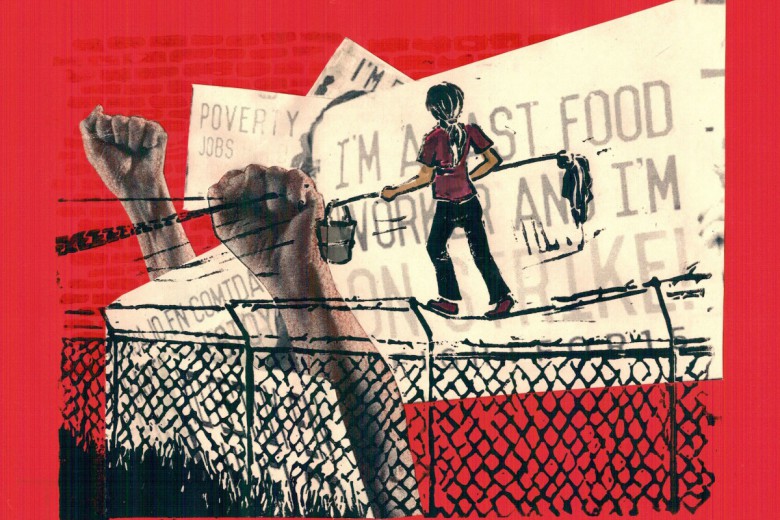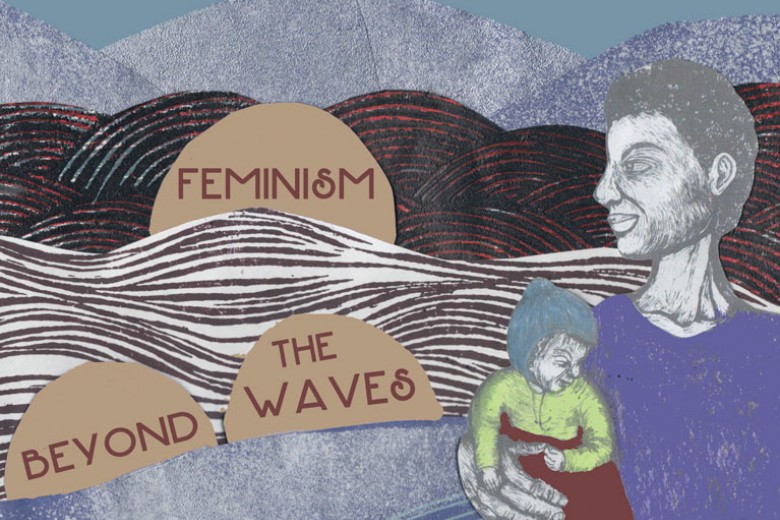
The economic boom that has hit Newfoundland and Labrador in recent years has received a lot of attention. The provincial government has played up recent economic growth, largely the result of a series of mining, offshore oil, and pending hydroelectric developments, but the boom has attracted its share of critics as well. Some argue the benefits – and jobs – are largely restricted to a small urban portion of the province, while others point out income inequality in Newfoundland is growing. Labour groups consistently emphasize that the share of provincial GDP going into corporate profits is the highest in the country, while the share going into workers’ salaries and wages is the lowest. Personal incomes are still below the national average.
But one area where the province has been making a concerted effort to improve its record is in diversifying the provincial workforce, and increasing the presence of women in the professional trades. It’s a daunting challenge for a field in which women account for only 6.4 per cent of the workforce nationwide.
Karen Walsh, executive director of the province’s Office to Advance Women Apprentices (OAWA), says it required acknowledgement that existing strategies weren’t working before real change could begin. The provincial government was pouring money into secondary school programs encouraging women to enter the trades, but while women’s enrolment in college-level trades programs increased, it wasn’t resulting in more women being hired.
“When they came out of college they were really struggling to get jobs. They weren’t getting jobs, but their male colleagues were,” says Walsh.
At this point, the provincial government decided to cast a wider net and ran ads seeking support from organizations that wanted to collaborate on supporting women in the trades.
The Carpenters Union responded. The union sat down with government and eventually worked out a partnership, which became the Office to Advance Women Apprentices. The Office was housed and resourced within the Carpenters Millwrights College – a union-run training facility – and supported by funding from government. In addition to funding the Office itself, the provincial government also introduced a wage subsidy program for employers that hired women (covering 90 per cent of wages for first-year women apprentices, 80 per cent for second-year, and 60 per cent for third- and fourth-year).
“Once industry saw that the government and the union were on board, they came on board,” explains Walsh.
Walsh believes the tripartite nature of the partnership has proven fundamental to its success.
“Government, industry, and unions have to be equal partners for this to take off. You can put on as many women’s courses as you like, but unless you have the major players all participating it’s not going to work.”
Measuring success
Walsh feels the initiatives are achieving results. Her office has a database of over 600 women apprentices, and has directly assisted over 200 women in getting jobs. The Office seizes opportunities as they arise. It proactively seeks out employers and tries to persuade them to hire women. Other times, employers seek them out, looking for workers or simply asking for advice around how to introduce women into their all-male workforce and make the adjustment as smooth as possible for everyone.
Critical to the OAWA’s success, Walsh says, is the fact that services don’t cease as soon as a woman is employed. Once women are hired, the Office maintains an active role in the relationship to ensure problems don’t arise.
“Once we get a job for a woman, we don’t say thank you and move on, but we monitor that relationship. We have constant emails and phone calls with the employers; we put on our hard hats and go into the fields; we interview them both to make sure they’re happy with each other, to make sure the apprentice is being treated fairly on the job. And the response back is that it’s working.”
In addition to building an infrastructure to support women in the trades, the province has been requiring companies to develop diversity plans before allowing them to proceed with development projects in the province. In a system unique to Newfoundland and Labrador, major projects are governed by ‘special project orders’ negotiated between government, unions and companies that will be involved in the work. These SPOs must include diversity plans outlining how all parties will support gender equity and workforce diversity initiatives, and mandating minimum targets the companies and unions must achieve.
Charlene Johnson is Minister of Child, Youth and Family Services, and also Minister Responsible for the Status of Women for the province. She’s adamant about the importance of requiring diversity.
“You don’t come to government asking to undertake a project in this province unless you’ve got a solid diversity plan that you bring with you,” she declares firmly. “The premier is very, very passionate about that.”
She credits much of the success of these initiatives to current Premier Kathy Dunderdale. Dunderdale held the portfolios of Minister of Natural Resources and Minister Responsible for the Status of Women when many of the agreements were negotiated.
“She took every opportunity to push it and she wanted to ensure women availed of every opportunity that appeared. These diversity plans, they are a requirement and a condition of release for a project to occur. It’s part of our environmental process. People often think the environment is just the natural environment, but environment includes the social and human aspects,” Johnson asserts.
Setting targets
How are the targets set? Johnson says there’s a process of negotiation that occurs. The government analyzes Statistics Canada data, coupled with data it collects from the colleges, to determine levels of available women in the trades. The companies, in turn, must develop a plan to achieve diversity targets.
The plans are quite detailed. The Women’s Employment Plan for Long Harbour sets a minimum of three per cent women apprentices in construction, 10 per cent women in design and engineering, and 25 per cent women overall. It also commits to mandatory gender sensitivity training for construction workers, zero tolerance for harassment, and requires adherence to the plan by subcontractors. The company also promises to financially support school-based initiatives to promote women in the trades, while the unions came up with the idea of paying 20 cents for every hour worked into a diversity fund to provide women apprentices with training scholarships.
“Nobody wants to set targets that aren’t achievable, but we don’t want them too low,” Johnson says. “We don’t want them to stagnate. Of the six employment plans we’ve negotiated, all the targets we’ve set have been met. Part of the agreement involves having a monitoring plan. They [industry] have to submit a report to government every year and they have to meet with us annually to go over the results. Some of these companies meet with us regularly. There is teeth to this; they absolutely have to meet those targets.”
Gus Doyle is president of the Carpenters Union, which has played a key role in supporting the OAWA. His union is the one that supplies many of the workers for the projects governed by these agreements, and he’s proud of the work they’ve been doing on improving diversity.
“In Newfoundland, we’re ahead of the game,” he says.
As the union supporting the OAWA, Doyle has worked hard to convince other unions of the need to support diversity. He said the response initially varied from union to union, but now most of the trade unions are on board and supportive. He thinks the diversity focus is here to stay.
“This is going to be entrenched in the workforce…Once they [employers] see that [women] can do the same job as the guys next door, they have got no problem with it. They’re adjusting quite well.”
Tempered enthusiasm
Some of those on the ground are more skeptical about the pace of change. Rosie* is a welder in her early 30s who has worked at some of the megaprojects. She has mixed feelings about what’s been accomplished, and feels there is a lot more that can still be done.
“I think that they’re dragging their heels,” she says, referring to all three parties. “It’s really exciting to see the shift that has already started. Are we there yet? I don’t think so. I think there’s a lot of ‘do as I say, not as I do’ still happening.”
One thing she is enthusiastic about is the work of the OAWA, whose success she’s seen first-hand.
“It should be in every province…They’ve done an amazing job of listening to the women on the ground. It’s that ear to the ground, right? And I’m glad they have that.”
Rosie has worked on enough projects to know where some of the major gaps exist. The constant layoffs are a problem.
“A lot of women are expected to give up permanent positions [outside the trades]…and know that it’s not going to be a permanent job. It might only be for six months. It might only be for two months. Some women who are single parents have commitments around taking care of their family. So it’s back-breaking for her to take an opportunity when she knows it’s good for her, but in a very bad way. There’s a real struggle there.”
She suggests that rather than laying off workers every few months when work slows down, government and employers should use that time to help workers upgrade skills and promote further skills development. Rosie also questions the on-site support for women.
“There is no support for women on these projects. None. There’s no support for the men either, but at least they have the numbers. A girl came to me and she said ‘you know I really wish we had a female shop steward. I wish there were a female unit to represent us, first of all, and to address the issues that we don’t feel comfortable talking to a man about.’ So if you did get harassed by somebody or if something has happened to you, safety issue or otherwise, that’s something you don’t feel comfortable talking about.”
Diverse dangers
Rosie also says the sites need more supervision, by supervisors trained to intervene. She’s had some close calls on work sites, and speaks from first-hand experience.
“When I was out there [on-site] last time…this guy exploded at me. I mean he drew back…it was violent. It was very violent. And I had no choice but to stand up to him because you simply can’t cower, you just can’t do that, on these sites you just can’t do it. That’s your whole reputation going out the window. I mean what can you do?”
In the end, she feels holding her ground led to her being laid off, and there was little the union could do about it.
It’s this sort of challenge that makes things particularly difficult for women seeking a place for themselves on work sites.
“There’s a lot of women out there who won’t say anything because they can’t say anything. Because there’s nobody for them to say it to.”
Working for change
Barriers still exist, but perhaps one of the benefits to the unique tripartite relationship that’s developed in Newfoundland and Labrador is that those barriers are increasingly identifiable.
Doyle notes that, from the unions’ perspective, smaller contractors are a big challenge: small, tight-knit employers who have never had women on their workforce and never had to consider issues like separate washroom facilities, or equipment and gear sized for both women and men.
Companies are still prone to hire based on experience, which often excludes many of the new women trying to enter the field and gain the experience to become journeypersons. A related problem is that women who received their training over the past few years and didn’t manage to gain employment are now finding themselves in need of retraining before they can avail themselves of new opportunities.
Still, they’re determined to keep the pressure on. And, despite the challenges, women like Rosie are enthusiastic about continuing to surge forward in their chosen careers.
“I love what I do. I love my job. I never question that. Sometimes it’s just really hard…so many things that seem to come out of an ice age movie happen in my career…and you’re just looking for somebody of your own kind… to know you’re not crazy. It can be hard sometimes.”
*This name has been changed at the source’s request.





_780_520_90_s_c1.jpg)
